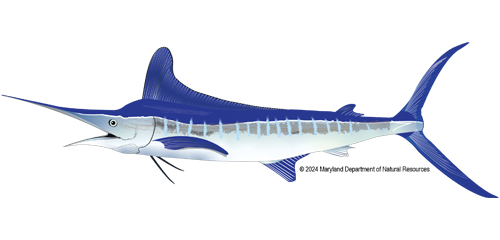| White Marlin |  |
White Marlin | | Tetrapturus albidus | (A.K.A. Billfish)
| Key Distinguishing Markings:
- The white marlin's upper jaw is twice as long as its lower jaw.
- The upper jaw forms a bill, which is long and slender in comparison to many other billfishes.
- The body is dark blue above and silvery white below, with brown spots on the sides of the white portion.
- In some specimens, many rows of blurred white lines may run the length of the body.
- The first dorsal fin, which runs almost the length of the body, is dark blue with many black spots, although these may fade towards the back of the fin.
- The second dorsal and pelvic fins are dark blue.
- First anal, first dorsal, and pectoral fins are blunt or rounded at tips.
- The pectoral fins and caudal fin are blackish brown; the long pectoral fins may be tipped in white.
- The body has a dense covering of bony scales.
- The lateral line is distinct, and with the exception of a single curve over the origin of the dorsal fin, runs straight along the body.
View the Marlin Gallery
| Distribution:
- White marlin are found in the Atlantic Ocean from roughly 45°N to 45°S in the southwestern Atlantic and 35°S in the southeastern Atlantic.
| Size:
- The white marlin is smaller than many other billfishes.
- The maximum length for the white marlin is 110 in and maximum weight is approximately 180 lbs.
- More commonly white marlin range from 51-83 inches in length.
| Habitat:
- Its distribution varies seasonally, reaching higher latitudes in both the northern and southern hemispheres only during the respective warm seasons.
- White marlin are considered oceanodromous, that is a migratory fish that migrates within the seas only.
| Spawning:
- Once a year, white marlin migrate into subtropical waters to spawn, with peak spawning occurring in early summer in deep oceanic waters.
- The spawning areas are found in deep and blue oceanic waters, generally at high temperatures ranging from 20° to 29°C.
- In the western North Atlantic, spawning grounds have been identified northeast of Little Bahama Bank, northwest of Grand Bahama Island, and southwest of Bermuda.
| Fishing Tips:
- The white marlin is a popular game fish, which can be caught trolling at or close to the surface.
- The largest fishery for this species occurs in the summer, between Cape Cod, Massachusetts, and Cape Hatteras, North Carolina.
- Baits including mullet, mackerel, herring, and squid as well as lures can be successful in getting a white marlin to bite on a line.
- When fishing for white marlin, wear protection on your hands, and take care in handling your catch; they are capable of inflicting serious wounds due to the roughness of the bill.
- A furious battler when hooked, white marlin engage in tail-walking and fantastic leaps into the air.
- The Highly Migratory Species Division (HMS) of the National Marine Fisheries Service (NMFS) manages Atlantic highly migratory species including Atlantic tunas, sharks, swordfish, billfish (blue marlin, white marlin, sailfish and longbill spearfish) and Atlantic swordfish to ensure long-term, sustainable fisheries for these species. Owners of vessels used to fish recreationally (i.e., no sale of fish) for Atlantic HMS (billfish, swordfish, sharks and tunas) are required to obtain an HMS Angling category permit from NMFS.
| Fun Fact:
- While swimming they commonly display a technique known as "tailing," in which only the dorsal lobe of the caudal fin is visible above the surface of the water.
- White marlin are generally not considered a schooling fish and most often occur solitarily or in pairs.
- Small schools of five to 12 fish are occasionally seen feeding on schools of bait, or tailing; however, loose aggregations of numerous fish scattered over fairly large areas are most typical.
- The State record for white marlin is 135 lbs, taken in Poor Man's Canyon in August 1980.
- White marlin live to be 25-30 years of age.
- Tagged white marlin have been recaptured after being at liberty for almost 12 years.
| | Family: Istiophoridae (Billfishes) | | Order: Perciformes (perch-likes) | | Class: Actinopterygii (ray-finned fishes) | For information concerning white marlin and their management, please contact Mike Luisi.
Illustration by Kevin Ensor,
Maryland Department of Natural Resources,
Fishing and Boating Services
|
|
